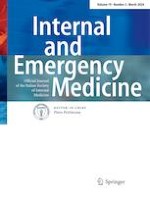Published in:

Open Access
20-11-2023 | IM - ORIGINAL
Physical activity in liver transplant recipients: a large multicenter study
Authors:
Stefano Gitto, Lucia Golfieri, Filippo Gabrielli, Margherita Falcini, Francesco Sofi, Maria Rosa Tamè, Nicola De Maria, Luca Marzi, Andrea Mega, Giovanna Valente, Alberto Borghi, Paolo Forte, Matteo Cescon, Fabrizio Di Benedetto, Pietro Andreone, Marco Petranelli, Maria Cristina Morelli, Paolo De Simone, Chloe Lau, Laura Stefani, Francesco Vizzutti, Francesca Chiesi, Fabio Marra, MEDITRA Research Group
Published in:
Internal and Emergency Medicine
|
Issue 2/2024
Login to get access
Abstract
Aim
Healthy lifestyle and appropriate diet are of critical importance after liver transplant (LT). We provided an analysis of the main patterns of physical activity and found factors associated with physical activity itself.
Methods
Clinically stable LT recipients were enrolled between June and September 2021. Patients completed a composite questionnaire about physical activity, adherence to Mediterranean Diet (MD), quality of life (QoL), and employment. Correlations were analysed using the Pearson coefficients while different subgroups were compared by t-test for independent samples or ANOVAs. Multivariable logistic regression analysis was conducted to find predictors of inactivity.
Results
We enrolled 511 subjects (71% males, mean age 63 ± 10.8 years). One hundred and ninety-three patients reported high level of physical activity, 197 a minimal activity and 121 declared insufficient activity. Among these latter, 29 subjects were totally inactive. Considering the 482 LT recipients performing some kind of physical activity, almost all reported a low-quality, non-structured activity. At multivariate analysis, time from LT (odds ratio 0.94, 95% CI 0.89–0.99, p = 0.017), sedentary lifestyle (odds ratio 0.99, 95% CI 0.19–0.81, p = 0.012), low adherence to MD (odds ratio 1.22, 95% CI 1.01–1.48, p = 0.049), and low level of QoL (physical dimension) (odds ratio 1.13, 95% CI 1.08–1.17, p < 0.001), were independently associated with total inactivity.
Conclusion
A large portion of LT recipients report an insufficient level of physical activity or are wholly inactive. Inactivity increases with time from LT and was strongly associated with suboptimal diet and low QoL.